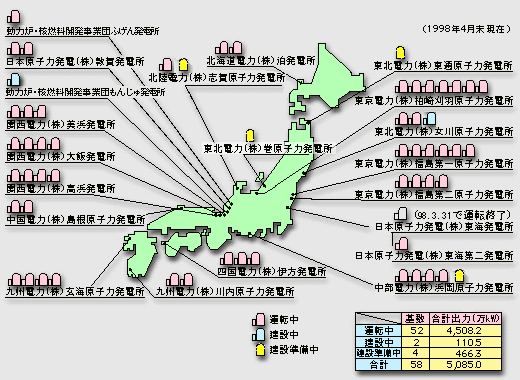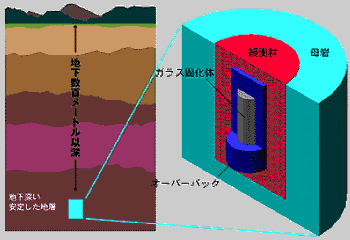The nuclear power plants in Japan,
52 sets are working as of July, 1999. (Fig. 1)  図1
図1
Operation of a nuclear reactor produces an immense quantity of artificial radioactivity. The plutonium which can make the Nagasaki type from atomic bomb 10,000 in one year, and the fission product for the Hiroshima type from atomic bomb 40,000 (the so-called fallout) is built. These artificial radioactivities are accumulated every year. The radioactivity which one nuclear reactor of 1 million-kw has will
be 2 quadrillion times the maximum permissible dose per person also one
day after that the operation stops . This is a serious threat for a living
thing including man. The strength of the radioactivity of a fission product will be 100 million times of the uranium fuel of a basis when a nuclear reactor has just stopped. Among these, the radioactivity of a short life generates a lot of collapse heat, and causes a nuclear core meltdown accident peculiar to a nuclear power plant. Moreover, a fission product takes 100,000 years for falling to the radioactivity level of a natural uranium ore because of its long-life time. This is over the time which man can manage. Then, research for embedding underground is advanced. ("Stratum
disposal" figure 2)
 figure 2
figure 2
How we should continue burying and
throwing it away on our mother earth? It really breasts our hurts. The Japanese Islands are a change belt with the most active diastrophism on the present earth. 10% of the earthquake in the world has happened in the Japanese Islands and its circumference ocean space. (Fig. 3)
Coordinating Committee for Earthquake Prediction of Japan specified the areas where the occurrence of an earthquake is expected in the near future to be a specific observation area and an observation strengthening area in 1978. (Fig. 4) The 26 of nuclear power plants of Japan are in a specific observation
area and an observation strengthening area. Moreover, no less than 14
plants in the Wakasa coast are near there. If these are united, it will
become 77% of the nuclear power plants of Japan.
Since the first nuclear power plant started operation, there has still been no nuclear plant which see and turn to the big earthquake. Does a nuclear power plant of Japan become the first case? "Hamaoka" situated right above the focus of the Tokai earthquake, "Shimane" in the Sea of Japan, and "Ikata" of medial line of Shikoku are the areas where we are anxious about the occurrence of the recent earthquakes. "Onagawa" in the Wakasa coast, "Kashiwazaki" near the Shin-etsu change belt, and Sanriku requires special attention. If a nuclear power plant meets a big earthquake, what does it become?
The day of an "experiment" is drawing near every moment. Atomic power weak to an earthquake : Collapse heat There is collapse heat which artificial radioactivity gives off as a nuclear essential weak point. As for the fuel of a nuclear reactor, after a stop continues generating heat in large quantities for collapse heat. Therefore, even if a nuclear reactor stops at an earthquake, in order to remove collapse heat, you have to continue cooling. A lot of cooling water is turned at the nuclear reactor in the United
States or Japan. (Fig. 5) If piping is damaged in an earthquake etc. and
cooling water is lost in large quantities, a fatal accident [say / meltdown
(nuclear core meltdown) ] will be caused.
Collapse heat is a phenomenon peculiar to atomic power. Atomic power breaks uranium (plutonium) artificially and makes energy emit. The fragment of the destroyed uranium (plutonium) becomes artificial radioactivity. The strength will be 100 million times [no less than] the uranium fuel of a basis. That radioactivity changes to automatically another nuclide. It becomes the no radioactive substance that does not change any more soon. A lot of heat called collapse heat is given off in this process. The collapse heat will be produced although the nuclear power plant operates or it stops, it generates independently and to stop the operation cannot reduce it, either. The life of radioactivity changes with kinds from a momentary thing to the thing for billions of years. The heat which the radioactivity of a short life will give off is very
extensive, if it sees by per time -- -- immediately after a nuclear reactor
stop -- one nuclear reactor of 1 million kW of electric outputs -- 210,000
-- kw(s) are reached after 1 hour -- 40,000 -- after kw(s) and 12 hours
-- 20,000 -- giving off the heat of 17,000kw(s) per a day. Fuel is close with the nuclear reactor of the United States and the Japan type. Therefore, there is no refuge of the collapse heat to generate. Cooling water will be boiled and lost if piping of the diameter of a large quantity is torn. If all cooling water is lost, a nuclear fission reaction will stop. However, for generation of heat by collapse heat, after 10 to 60 minutes, the temperature of a fuel bundle becomes to thousands degrees and melts and falls. This is called nuclear core meltdown (meltdown). (Fig. 6) The steel of a nuclear reactor will also be melted in 30 to 120 minutes.
A phreatic explosion will be started, if it melts and the fuel that fell
touches water. If a nuclear reactor container is destroyed, a big accident
exceeding CHIERUNOVIRI will be caused.
Cooling water was lost owing to what a stop of a feed pump and a valve did not close for the accident which occurred at the Three Mile Island nuclear power plant No. 2 furnace in the United States, and 50% or more of fuel melted and fell in 1979. Since there was no damage in piping outside a furnace, it succeeds in end cooling-water re-pouring of the hard fighting for several days, and the destruction of a nuclear reactor was not occurred. Before this accident, the nuclear core meltdown accident was claimed not to happen. All nuclear power plant construction was stopped in the United States after this accident. By decommissioning, the number of the nuclear reactors in the United States is becoming fewer.
|
|||
| Please refer to this URL for details. (Japanese) |